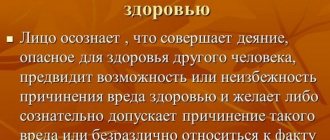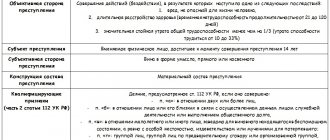1. It is not a crime to cause harm to a person who has committed a crime when he is detained to be brought to the authorities and to suppress the possibility of him committing new crimes, if it was not possible to detain such a person by other means and the measures necessary for this were not exceeded.
2. Exceeding the measures necessary to detain a person who has committed a crime is recognized as their obvious discrepancy with the nature and degree of public danger of the crime committed by the detainee and the circumstances of the detention, when the person is unnecessarily caused clearly excessive harm not caused by the situation. Such an excess entails criminal liability only in cases of intentional harm.
- Article 37. Necessary defense
- Article 39. Extreme necessity
Commentary to Art. 38 of the Criminal Code of the Russian Federation
Detaining a person who has committed a crime is the right, and sometimes the moral duty, of any citizen. It is an official duty for a number of law enforcement officials and other departments. In accordance with Art. 38 of the Criminal Code of the Russian Federation, it is not a crime to cause harm to a person who has committed a crime when he is detained in order to bring him to the authorities and suppress the possibility of him committing new crimes, if it was not possible to detain such a person by other means and the measures necessary for this were not exceeded.
This provision of criminal law applies only in cases where harm during arrest is caused to the person who committed the crime. Thus, the legislator establishes the first two signs that make it possible to distinguish between the institutions of necessary defense and detention. Firstly, the necessary defense is applied not only in cases where a crime is committed, but also in cases of other socially dangerous attacks, and causing harm during detention will be lawful only if the detainee commits a crime. Secondly, with the necessary defense, harm is caused to the attacker during the period of the attack until its completion. Detention is carried out after the end of the crime or after its suppression, but in the period after the cessation of the attack. In cases where the criminal resists or uses violence against the persons carrying out the arrest, the latter have the right to the necessary defense, which is a very important circumstance when assessing the legality of the actions of the detainee, since causing harm during the necessary defense is limited to a less strict framework than causing harm during detention. What distinguishes the institution of detention from necessary defense is their intended purpose. Necessary defense is carried out in order to protect the individual, the rights of the defender or other persons, the interests of society or the state protected by law, and the detention of a person who has committed a crime - in order to deliver him to the authorities and to suppress the possibility of the detainee committing new crimes.
Causing harm during the detention of a person who has committed a crime will be lawful if the measures necessary for detention were not exceeded, and if it was not possible to detain the person by other means.
Exceeding the measures necessary to detain a person who has committed a crime is recognized as their obvious discrepancy with the nature and degree of public danger of the crime committed by the detainee and the circumstances of the detention, when the person is unnecessarily caused excessive harm not caused by the situation. Such an excess entails criminal liability only in cases of murder (Part 2 of Article 108 of the Criminal Code of the Russian Federation), as well as intentional infliction of grievous or moderate harm to health (Part 2 of Article 114 of the Criminal Code of the Russian Federation). These crimes are intentional crimes. Therefore, in the event of harm caused by exceeding the measures necessary to detain a person who committed a crime, the perpetrator is aware of the social danger of his actions, his consciousness embraces the fact that the measures of detention are clearly inconsistent with the nature and degree of public danger of the crime committed by the detainee and the circumstances of the detention in particular, and the fact that the harm caused is excessive and not caused by necessity. In this regard, causing harm by negligence during arrest does not entail criminal liability.
When deciding whether to exceed the measures necessary for detention, the nature and danger of the crime committed should be taken into account. Thus, it is unlikely that serious harm to health should be caused to a person who has committed a minor crime.
The circumstances surrounding the arrest must also be taken into account. Here the law establishes fairly strict conditions, allowing the possibility of causing harm during detention only when it was not possible to detain the person by other means. Therefore, from our point of view, it is impossible to recognize as lawful a detention committed with the use of a firearm, even against a person who has committed a particularly serious crime, if this person could have been detained in other ways.
When assessing the legality of detention, many other factors must be taken into account, for example, the number of detainees, their age, physical development, condition at the time of detention (for example, state of intoxication), armament of the detainees, etc. In this regard, the assessment of the legality of causing harm during detention should be carried out taking into account the specific circumstances in each specific case.
A prerequisite for the legality of causing harm when detaining a person who has committed a crime is the purpose of the detention. Its purpose is to implement the tasks of justice, bringing a person to criminal responsibility, restoring justice, and preventing crimes. The purpose of detention is to bring a person to the authorities and prevent the possibility of him committing new crimes. In relation to the institution of detention, the authorities to which the detainee is delivered should include not only law enforcement, but also other bodies where measures can be taken to prevent the detainee from committing new crimes and transfer the detainee to the authorities competent in resolving the issue of bringing the perpetrator to criminal charges. responsibility.
To summarize, we can highlight the following signs that determine the legality of causing harm during detention. The first group of signs characterizes the grounds and purpose of the detention, and the second - the conditions for the detention.
1. Detention is carried out:
- only in relation to the person who committed the crime. In this case, the right of detention is retained from the time the crime was committed until the expiration of the statute of limitations;
- only for the purpose of delivering the detainee to the authorities or suppressing the possibility of the detainee committing new crimes.
2. Upon arrest:
- causing harm is permissible only when it is impossible to detain the person who committed the crime by other means;
- the harm caused must correspond to the nature and degree of danger of the act committed by the detainee, his personality and the circumstances of the detention;
- exceeding the measures to detain a person who committed a crime can only occur in the case of causing excessive harm intentionally and cannot be recognized when causing harm through negligence (or as a result of an incident, case).
If the detainee makes a conscientious mistake regarding the circumstances of the detention, the legal assessment of the offense is carried out in the same way as in the case of necessary defense.
Exceeding the measures necessary to apprehend a person who has committed a crime
Although the limits of causing harm when a person is detained are fixed by law, they remain dependent on objective reasons caused by the development of society. Thus, “The Russian Criminal Code of 1903 established the presumption of the legality of causing any harm to the offender in all cases. Exceeding the limits of necessary defense... entailed punishment only in cases specifically specified in the law: deprivation of life or infliction of grievous bodily harm.” (7, p. 62)
The modern Criminal Code gives the following assessment of exceeding the limits of causing harm: “Exceeding the measures necessary to detain a person who has committed a crime is recognized as their obvious inconsistency with the nature and degree of public danger of the crime committed by the detainee and the circumstances of the detention, when the person is unnecessarily inflicted on a clearly excessive, not caused the situation is harmful. Such an excess entails criminal liability only in cases of intentional harm.” (1, art. 38, clause 2)
Speaking about the excess of measures necessary to detain a person who has committed a crime, “the law emphasizes not a simple discrepancy, but a clear discrepancy between the measures and the nature and danger of the crime, the situation of the entire set of circumstances of the detention.” (5, p. 89)
From the definition of the above excess of measures of causing harm to a criminal during arrest, it follows “that it is possible in the following cases:
§ when the harm caused to the criminal clearly did not correspond to the danger of the attack he committed, but corresponded to the circumstances of his detention;
§ when the harm caused to the criminal was commensurate with the danger of the attack he committed, but clearly did not correspond to the favorable environment of his detention.
Obviously, in the first case we are talking about exceeding the limits of permissible harm, and in the second – about exceeding the limits of sufficient harm when detaining a criminal.
Taking into account the above, we can give definitions of two types of exceeding the limits of causing harm.
Exceeding the limits of permissible harm
- this is the infliction of grievous harm to a criminal in an unfavorable situation of detention, clearly exceeding the actual or potential harm that the criminal caused or intended to cause to a specific target of the attack.
Exceeding the limits of sufficient harm
- this is the infliction of grievous harm on a criminal in a favorable situation of detention, clearly exceeding the harm that was sufficient for his detention.”
(4, p.133)
Analyzing the material presented, we can conclude that liability for exceeding the measures necessary to detain a person who committed a crime may occur if it is established that:
· the arrest of the criminal was carried out in accordance with the law;
· the harm caused to the criminal during the arrest complied with the conditions of legality regarding its compulsion, direction and purpose;
· only the condition of proportionality of the harm caused to the criminal is not met.
According to paragraph 4 of the resolution of August 16, 1994, the actions of persons to cause harm to a person “who has encroached or been detained, if they acted in accordance with the requirements of charters, regulations and other regulations providing for the basis and procedure for the use of force and weapons” are not unlawful. . (3, p.248)
example: meat processing plant watchman S. saw that P. and K. entered the territory of the meat processing plant for the purpose of theft. Seeing the watchman, they abandoned their intentions and ran to the hole in the fence. Trying to stop and detain them, the watchman shouted: “Stop!” and fired a warning shot. The next shot killed P., and caused minor bodily injury to K., which did not cause health problems. In this case, the watchman acted with the aim of suppressing a socially dangerous attack on the part of P. and K.. and detaining them. However, the circumstances of the case show that at the moment when S. fired a shot aimed at the victims, the criminal attack of the latter was stopped at the attempted stage, and their actions did not threaten either state property, since they did not take possession of the meat products, or the person causing the harm. Carrying out the detention, S. used measures that were clearly more dangerous than the assault committed by K. and P., thus exceeding the measures necessary to cause harm when detaining criminals. (8, 1985, no. 5, p. 5)
Conclusion
Based on a literature review on the topic “Causing harm when detaining a person who has committed a crime,” the author of this work concludes that this institution has not yet been fully studied. Many authors, in particular Mikhailov V.I., Baulin Yu.V. and Ponomar V. offer their formulations of norms describing this institution, in their opinion, more accurately and legally competent. The institution of causing harm during detention contains the following contradictions:
§ an act is not considered criminal if it is not recognized by a court (Article 49 of the Constitution of the Russian Federation); at the time of arrest it is unknown whether the detained person will be found guilty;
§ the person who is allowed to cause harm is not described in detail; Could it be an insane person, a minor, or a person who happened to be at the crime scene?
In civil legislation, according to V. Ponomar, there are also no clear regulations regarding cases of causing excessive harm during the detention of persons who have committed a crime: “following the rules of Art. 1066 of the Civil Code, if excessive harm is caused to a person, those who caused it must bear responsibility to the victim on a general basis. ...This situation has a negative impact on law enforcement activities. Such a legal gap, on the one hand, restrains the social activity of citizens who provide assistance in the fight against crime, and on the other, does not create certain guarantees for the civil protection of offenders and other persons who have suffered from disproportionate measures to suppress their actions.” (2)
Consequently, the institution of causing harm during detention to a person who has committed a crime represents a vast field for the law-making activities of Russian lawyers.
Bibliography:
1. Criminal Code of the Russian Federation
2. Ponomar V. Civil liability for causing “excessive” harm during the detention of a criminal. // Russian justice 1998 No. 12, p. 21-22
3. Collection of decisions of the Plenum of the Supreme Court of the Russian Federation. 1963 –1993, Moscow: 1994
4. Baulin Yu.V. The right of citizens to apprehend a criminal. Kharkov, 1986
5. Commentary on the Criminal Code of the Russian Federation, ed. Kuznetsova N.F. M: 1998
6. Martsev A.I., Tsaregorodtsev A.M. Necessary defense. Detention of a criminal. An urgent need. // Omsk: 1987
7. Mikhailov V.I. On the socio-legal aspect of the content of circumstances excluding the criminality of an act. // State and law. 1995, No. 12
8. Bulletin of the Supreme Court of the Russian Federation
9. B. Razgildyaev. “Socially beneficial acts provided for by the Criminal Code” // Legality 1993 No. 12, p. 18-21.
Problem solving
Task 1.
Fedotov and Sorokin, having carried out an armed attack on Sberbank, took possession of a bag containing 1 million. rubles When they jumped out of the savings bank, a random passer-by, realizing what was happening, tried to detain them, but was killed by them. Police officers came running to hear the shots and began to pursue the fleeing criminals. During the persecution, Fedotov was seriously injured, and Sorokin was killed.
Do the actions of police officers exceed the measures necessary to detain a person who has committed a crime?
ü The actions of the criminal posed a great danger to people who happened to be on the street at the time of the crime. The criminals killed a man who tried to detain them.
ü The harm caused to the criminal was forced, necessary; it was impossible to eliminate the public danger in any other way.
ü The purpose of causing harm is to suppress a dangerous attack and bring the criminals to the appropriate authorities.
ü The harm caused was clearly proportionate to the danger of the assault committed.
Criminal Code of the Russian Federation Article No. 38, clause 2: “Exceeding the measures necessary to detain a person who has committed a crime is recognized as their obvious inconsistency with the nature and degree of public danger of the crime committed by the detainee.”
An excess of such measures are considered actions that are not “necessary for detention, clearly inconsistent with the nature and danger of the crime” (Resolution of the Plenum of the Armed Forces of the Russian Federation No. 14 of August 16, 1984, paragraph 3)
Consequently, the actions of the police officers did not exceed the measures necessary to detain the criminal.
Task 2.
16-year-old Snegirev, Vasiliev and Noskov tried to rape the girl. Seeing the approaching police officer, they began to run away. While chasing Snegirev, the police officer suggested that the runaway stop and fired a warning shot, but Snegirev continued to run away and began to move away from the police officer. The aimed shot caused serious harm to Snegirev's health.
Is it legal to cause grievous bodily harm in this case?
ü The basis for causing harm was violated: a person who did not commit a crime, or rather, refused to complete the criminal act, tried to escape.
ü The condition of proportionality of harm was violated: the harm caused clearly exceeded the danger of the attack committed by the criminal.
In accordance with paragraph 3 of Resolution of the Plenum of the Armed Forces of the Russian Federation No. 14 of August 16, 1984, it is not considered lawful to cause harm during detention to a person whose actions “clearly did not correspond to the nature and danger of the attack.” In such cases, Article 38 of the Criminal Code of the Russian Federation qualifies the actions of the person who caused the harm as unlawful.
Therefore, the actions of a police officer to cause harm to a criminal are unlawful.
Task 3.
Turov and Serov, armed with homemade machine guns, pressed the cashier returning from the savings bank. Turov tried to take away the cashier’s bag at gunpoint, and Serov attacked the driver, intending to take the ignition keys in order to escape in a car with the stolen money. However, the cashier managed to run into the guardhouse, and the driver, despite the threat with a weapon, did not give up the keys. Realizing that they were unable to get hold of the money, Turov and Serov tried to escape. The cashier organized the pursuit of the criminals, during which Turov suffered minor harm to his health, and Serov suffered moderate harm to his health.
In this case, were the conditions for the legality of causing harm met when apprehending the person who committed the crime?
ü The condition for the basis of detention is not met: Art. 38 clause 1 of the Criminal Code of the Russian Federation notes that the purpose of detaining a person who has committed a crime is “delivery to the authorities.” In this case, the detainees clearly pursued a different goal - reprisal against the criminal.
ü The criminals refused to complete their attack, so the harm caused clearly does not correspond to the nature of the danger of the crime they committed.
10. Consequently, on the basis of Art. No. 38 of the Criminal Code of the Russian Federation and paragraph 3 of the resolution of the Plenum of the Armed Forces of the Russian Federation No. 14 of August 16, 1984, it can be argued that in this case the conditions for the legality of causing harm when detaining a person who committed a crime were not met.
Although the limits of causing harm when a person is detained are fixed by law, they remain dependent on objective reasons caused by the development of society. Thus, “The Russian Criminal Code of 1903 established the presumption of the legality of causing any harm to the offender in all cases. Exceeding the limits of necessary defense... entailed punishment only in cases specifically specified in the law: deprivation of life or infliction of grievous bodily harm.” (7, p. 62)
The modern Criminal Code gives the following assessment of exceeding the limits of causing harm: “Exceeding the measures necessary to detain a person who has committed a crime is recognized as their obvious inconsistency with the nature and degree of public danger of the crime committed by the detainee and the circumstances of the detention, when the person is unnecessarily inflicted on a clearly excessive, not caused the situation is harmful. Such an excess entails criminal liability only in cases of intentional harm.” (1, art. 38, clause 2)
Speaking about the excess of measures necessary to detain a person who has committed a crime, “the law emphasizes not a simple discrepancy, but a clear discrepancy between the measures and the nature and danger of the crime, the situation of the entire set of circumstances of the detention.” (5, p. 89)
From the definition of the above excess of measures of causing harm to a criminal during arrest, it follows “that it is possible in the following cases:
§ when the harm caused to the criminal clearly did not correspond to the danger of the attack he committed, but corresponded to the circumstances of his detention;
§ when the harm caused to the criminal was commensurate with the danger of the attack he committed, but clearly did not correspond to the favorable environment of his detention.
Obviously, in the first case we are talking about exceeding the limits of permissible harm, and in the second – about exceeding the limits of sufficient harm when detaining a criminal.
Taking into account the above, we can give definitions of two types of exceeding the limits of causing harm.
Exceeding the limits of permissible harm
- this is the infliction of grievous harm to a criminal in an unfavorable situation of detention, clearly exceeding the actual or potential harm that the criminal caused or intended to cause to a specific target of the attack.
Exceeding the limits of sufficient harm
- this is the infliction of grievous harm on a criminal in a favorable situation of detention, clearly exceeding the harm that was sufficient for his detention.”
(4, p.133)
Analyzing the material presented, we can conclude that liability for exceeding the measures necessary to detain a person who committed a crime may occur if it is established that:
· the arrest of the criminal was carried out in accordance with the law;
· the harm caused to the criminal during the arrest complied with the conditions of legality regarding its compulsion, direction and purpose;
· only the condition of proportionality of the harm caused to the criminal is not met.
According to paragraph 4 of the resolution of August 16, 1994, the actions of persons to cause harm to a person “who has encroached or been detained, if they acted in accordance with the requirements of charters, regulations and other regulations providing for the basis and procedure for the use of force and weapons” are not unlawful. . (3, p.248)
example: meat processing plant watchman S. saw that P. and K. entered the territory of the meat processing plant for the purpose of theft. Seeing the watchman, they abandoned their intentions and ran to the hole in the fence. Trying to stop and detain them, the watchman shouted: “Stop!” and fired a warning shot. The next shot killed P., and caused minor bodily injury to K., which did not cause health problems. In this case, the watchman acted with the aim of suppressing a socially dangerous attack on the part of P. and K.. and detaining them. However, the circumstances of the case show that at the moment when S. fired a shot aimed at the victims, the criminal attack of the latter was stopped at the attempted stage, and their actions did not threaten either state property, since they did not take possession of the meat products, or the person causing the harm. Carrying out the detention, S. used measures that were clearly more dangerous than the assault committed by K. and P., thus exceeding the measures necessary to cause harm when detaining criminals. (8, 1985, no. 5, p. 5)
Conclusion
Based on a literature review on the topic “Causing harm when detaining a person who has committed a crime,” the author of this work concludes that this institution has not yet been fully studied. Many authors, in particular Mikhailov V.I., Baulin Yu.V. and Ponomar V. offer their formulations of norms describing this institution, in their opinion, more accurately and legally competent. The institution of causing harm during detention contains the following contradictions:
§ an act is not considered criminal if it is not recognized by a court (Article 49 of the Constitution of the Russian Federation); at the time of arrest it is unknown whether the detained person will be found guilty;
§ the person who is allowed to cause harm is not described in detail; Could it be an insane person, a minor, or a person who happened to be at the crime scene?
In civil legislation, according to V. Ponomar, there are also no clear regulations regarding cases of causing excessive harm during the detention of persons who have committed a crime: “following the rules of Art. 1066 of the Civil Code, if excessive harm is caused to a person, those who caused it must bear responsibility to the victim on a general basis. ...This situation has a negative impact on law enforcement activities. Such a legal gap, on the one hand, restrains the social activity of citizens who provide assistance in the fight against crime, and on the other, does not create certain guarantees for the civil protection of offenders and other persons who have suffered from disproportionate measures to suppress their actions.” (2)
Consequently, the institution of causing harm during detention to a person who has committed a crime represents a vast field for the law-making activities of Russian lawyers.
Bibliography:
1. Criminal Code of the Russian Federation
2. Ponomar V. Civil liability for causing “excessive” harm during the detention of a criminal. // Russian justice 1998 No. 12, p. 21-22
3. Collection of decisions of the Plenum of the Supreme Court of the Russian Federation. 1963 –1993, Moscow: 1994
4. Baulin Yu.V. The right of citizens to apprehend a criminal. Kharkov, 1986
5. Commentary on the Criminal Code of the Russian Federation, ed. Kuznetsova N.F. M: 1998
6. Martsev A.I., Tsaregorodtsev A.M. Necessary defense. Detention of a criminal. An urgent need. // Omsk: 1987
7. Mikhailov V.I. On the socio-legal aspect of the content of circumstances excluding the criminality of an act. // State and law. 1995, No. 12
8. Bulletin of the Supreme Court of the Russian Federation
9. B. Razgildyaev. “Socially beneficial acts provided for by the Criminal Code” // Legality 1993 No. 12, p. 18-21.
Problem solving
Task 1.
Fedotov and Sorokin, having carried out an armed attack on Sberbank, took possession of a bag containing 1 million. rubles When they jumped out of the savings bank, a random passer-by, realizing what was happening, tried to detain them, but was killed by them. Police officers came running to hear the shots and began to pursue the fleeing criminals. During the persecution, Fedotov was seriously injured, and Sorokin was killed.
Do the actions of police officers exceed the measures necessary to detain a person who has committed a crime?
ü The actions of the criminal posed a great danger to people who happened to be on the street at the time of the crime. The criminals killed a man who tried to detain them.
ü The harm caused to the criminal was forced, necessary; it was impossible to eliminate the public danger in any other way.
ü The purpose of causing harm is to suppress a dangerous attack and bring the criminals to the appropriate authorities.
ü The harm caused was clearly proportionate to the danger of the assault committed.
Criminal Code of the Russian Federation Article No. 38, clause 2: “Exceeding the measures necessary to detain a person who has committed a crime is recognized as their obvious inconsistency with the nature and degree of public danger of the crime committed by the detainee.”
An excess of such measures are considered actions that are not “necessary for detention, clearly inconsistent with the nature and danger of the crime” (Resolution of the Plenum of the Armed Forces of the Russian Federation No. 14 of August 16, 1984, paragraph 3)
Consequently, the actions of the police officers did not exceed the measures necessary to detain the criminal.
Task 2.
16-year-old Snegirev, Vasiliev and Noskov tried to rape the girl. Seeing the approaching police officer, they began to run away. While chasing Snegirev, the police officer suggested that the runaway stop and fired a warning shot, but Snegirev continued to run away and began to move away from the police officer. The aimed shot caused serious harm to Snegirev's health.
Is it legal to cause grievous bodily harm in this case?
ü The basis for causing harm was violated: a person who did not commit a crime, or rather, refused to complete the criminal act, tried to escape.
ü The condition of proportionality of harm was violated: the harm caused clearly exceeded the danger of the attack committed by the criminal.
In accordance with paragraph 3 of Resolution of the Plenum of the Armed Forces of the Russian Federation No. 14 of August 16, 1984, it is not considered lawful to cause harm during detention to a person whose actions “clearly did not correspond to the nature and danger of the attack.” In such cases, Article 38 of the Criminal Code of the Russian Federation qualifies the actions of the person who caused the harm as unlawful.
Therefore, the actions of a police officer to cause harm to a criminal are unlawful.
Task 3.
Turov and Serov, armed with homemade machine guns, pressed the cashier returning from the savings bank. Turov tried to take away the cashier’s bag at gunpoint, and Serov attacked the driver, intending to take the ignition keys in order to escape in a car with the stolen money. However, the cashier managed to run into the guardhouse, and the driver, despite the threat with a weapon, did not give up the keys. Realizing that they were unable to get hold of the money, Turov and Serov tried to escape. The cashier organized the pursuit of the criminals, during which Turov suffered minor harm to his health, and Serov suffered moderate harm to his health.
In this case, were the conditions for the legality of causing harm met when apprehending the person who committed the crime?
ü The condition for the basis of detention is not met: Art. 38 clause 1 of the Criminal Code of the Russian Federation notes that the purpose of detaining a person who has committed a crime is “delivery to the authorities.” In this case, the detainees clearly pursued a different goal - reprisal against the criminal.
ü The criminals refused to complete their attack, so the harm caused clearly does not correspond to the nature of the danger of the crime they committed.
10. Consequently, on the basis of Art. No. 38 of the Criminal Code of the Russian Federation and paragraph 3 of the resolution of the Plenum of the Armed Forces of the Russian Federation No. 14 of August 16, 1984, it can be argued that in this case the conditions for the legality of causing harm when detaining a person who committed a crime were not met.
Judicial practice under Article 38 of the Criminal Code of the Russian Federation
Determination of the Judicial Collegium for Criminal Cases of the Supreme Court of the Russian Federation dated September 26, 2017 N 9-N17-1
In accordance with Art. Under the Criminal Code of the RSFSR, execution was replaced by imprisonment for 8 years with strict isolation and with loss of rights for 5 years, with confiscation of property and in compliance with Art. Criminal Code of the RSFSR with credit for pre-trial detention of 9 months 28 days.
Determination of the Constitutional Court of the Russian Federation dated December 19, 2019 N 3306-O
Also, in the resolution of the Plenum of the Supreme Court of the Russian Federation dated September 27, 2012 N “On the application by courts of legislation on necessary defense and causing harm when detaining a person who has committed a crime,” it is explained that actions cannot be recognized as committed in a state of necessary defense if harm is caused to the offender after the encroachment was prevented, suppressed or completed and there was clearly no need for the use of protective measures, which was realized by the person defending; in such cases, depending on the specific circumstances of the case, the harm caused to the offender may be assessed according to the rules of the article of the Criminal Code of the Russian Federation, or the person defending himself shall be liable on a general basis; in order to correctly evaluate such actions legally, the courts, taking into account all the circumstances of the case, must find out whether they were committed by the person defending himself in a state of sudden strong emotional excitement (affect) caused by a socially dangerous attack (clause 7); the transfer of weapons or other objects used as weapons during an attack from the attacker to the person defending cannot in itself indicate the end of the attack if, taking into account the intensity of the attack, the number of attackers, their age, gender, physical development and other circumstances, the a real threat of continuation of such an attack (paragraph four of paragraph 8).
Resolution of the Plenum of the Supreme Court of the Russian Federation dated June 29, 2021 N 21
The provisions of the articles and the Criminal Code of the Russian Federation apply to private security guards who, in connection with the performance of their duties, may take part in suppressing socially dangerous attacks or in detaining a person who has committed a crime. Moreover, if, as a result of exceeding the limits of necessary defense or measures necessary to detain a person who has committed a crime, a private security guard commits murder or intentional infliction of grievous or moderate harm to health, what he has done, if there are appropriate signs, is subject to qualification under Article 108 or Article 114 Criminal Code of the Russian Federation.
Determination of the Constitutional Court of the Russian Federation dated February 28, 2019 N 542-O
The resolution of the Plenum of the Supreme Court of the Russian Federation dated September 27, 2012 N “On the application by courts of legislation on necessary defense and causing harm when detaining a person who has committed a crime” clarifies that actions cannot be recognized as committed in a state of necessary defense if harm was caused to the offender after how the encroachment was prevented, suppressed or ended and the use of protective measures was clearly no longer necessary, which was realized by the person defending; in such cases, depending on the specific circumstances of the case, the harm caused to the offender may be assessed according to the rules of the article of the Criminal Code of the Russian Federation, or the person defending himself shall be liable on a general basis; in order to correctly evaluate such actions legally, the courts, taking into account all the circumstances of the case, must find out whether they were committed by the person defending himself in a state of sudden strong emotional excitement (affect) caused by a socially dangerous attack (clause 7); the transfer of weapons or other objects used as weapons during an attack from the attacker to the person defending cannot in itself indicate the end of the attack if, taking into account the intensity of the attack, the number of attackers, their age, gender, physical development and other circumstances, the a real threat of continuation of such an attack (paragraph three of paragraph 8).
“Review of the practice of application by courts of the provisions of Chapter 8 of the Criminal Code of the Russian Federation on circumstances excluding the criminality of an act”
Issues of application of the provisions of the criminal law on circumstances excluding the criminality of an act are explained in the resolution of the Plenum of the Supreme Court of the Russian Federation dated September 27, 2012 N “On the application by courts of legislation on necessary defense and causing harm when detaining a person who has committed a crime” (hereinafter referred to as the resolution of the Plenum) . These clarifications contribute to the formation of a uniform practice of applying articles , , 108 and 114 of the Criminal Code of the Russian Federation.









